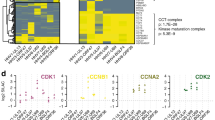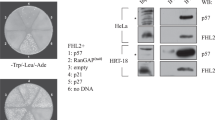Abstract
Cdk9 is a member of the Cdc2-like family of kinases. It binds to members of the family of cyclin T (T1, T2a and T2b) and to cyclin K. The Cdk9/cyclin T complex appears to be involved in regulating several physiological processes. In fact Cdk9 is the kinase of the P-TEFb complex, involved in basal transcription. Cdk9 has also been described as the kinase of the TAK complex, homologous to P-TEFb and involved in HIV replication. Here we show that Cdk9 interacts with gp130, the receptor of the Interleukin-6 (IL-6) family of cytokines, which includes Leukemia Inhibitory Factor (LIF), Oncostatin M (OSM), Ciliary Neurotrophic Factor (CNTF), Interleukin-11 (IL-11) and Cardiotrophin (CT-1). IL-6 is a key regulator of hematopoiesis, immunological responses and inflammation. In addition, IL-6 plays a major role in the endocrine and nervous systems. Signal transduction by gp130 is mediated by physical interaction of the cytoplasmic region of gp130 with cellular kinases and results in the transcriptional activation of cellular and viral genes. We found that Cdk9 interacts in vitro with the cytoplasmic region of gp130 and we succeded in reproducing this interaction in vivo. Cdk9 expression was found both in the nucleus and in the cytoplasm. The binding occurring between Cdk9 and gp130 increased upon IL-6 stimulation. We also observed that Cdk9 synergized with IL-6 in inducing the activation of an IL-6-responsive reporter plasmid. In summary, these results point to a previously undisclosed role for Cdk9 in signal transduction.
This is a preview of subscription content, access via your institution
Access options
Subscribe to this journal
Receive 50 print issues and online access
$259.00 per year
only $5.18 per issue
Buy this article
- Purchase on Springer Link
- Instant access to full article PDF
Prices may be subject to local taxes which are calculated during checkout





Similar content being viewed by others
References
Akira S, Taga T, Kishimoto T . 1993 Adv. Immunol. 54: 1–78
Boulton TG, Stahl N, Yancopoulos GD . 1994 J. Biol. Chem. 269: 648–655
Bagella L, MacLachlan TK, Buono RJ, Pisano MM, Giordano A, De Luca A . 1998 J. Cell Physiol. 177: 206–213
Bellan C, De Falco G, Lazzi S, Scherfeld K, Micheli P, Bartolommei S, Vestri M, Nyongo A, Pileri S, Leoncini L, Tosi P, Giordano A . 2002 J. Clin. Pathol. 55: Suppl 1 A29
Bullrich F, MacLachlan T, Sang N, Druck T, Veronese ML, Allen S, Chiorazzi N, Koff A, Heubner K, Croce CM, Giordano A . 1995 Cancer Res. 55: 1199–1205
Chun TW, Engel D, Mizell SB, Ehler LA, Fauci AS . 1998 J. Exp. Med. 188: 83–91
De Falco G, Bagella L, Claudio PP, De Luca A, Fu Y, Calabretta B, Sala A, Giordano A . 2000 Oncogene 19: 373–379
De Falco G, Giordano A . 2002 Cancer Biol. Ther. 1: 66–69
De Luca A, Esposito V, Baldi A, Claudio PP, Fu Y, Caputi M, Pisano MM, Baldi F, Giordano A . 1997 J. Cell. Physiol. 172: 265–273
Foskett SM, Ghose R, Tang DN, Lewis DE, Rice AP . 2001 J. Virol. 75: 1220–1228
Fu TJ, Peng J, Lee GA, Price DH, Flores O . 1999 J. Biol. Chem. 274: 34527–34530
Ghose R, Liou LY, Herrmann CH, Rice AP . 2001 J. Virol. 75: 11336–11343
Giordano V, De Falco G, Ambrosino C, Ruocco MR, Quinto I, Pelicci PG, Del Mastro P, Scala G . 1997 J. Immun. 158: 4097–4103
Graña X, De Luca A, Sang N, Fu Y, Claudio PP, Rosenblatt J, Morgan DO, Giordano A . 1994 Proc. Nat. Acad. Sci. USA 91: 3834–3838
Hanks SK, Quinn AM, Hunter T . 1988 Science 241: 42–52
Herrmann CH, Carroll RG, Wei P, Jones KA, Rice AP . 1998 J. Virol. 72: 9881–9888
Ihle JN . 1996 Cell 84: 331–334
Kishimoto T, Akira S, Taga T . 1992 Science 258: 593–597
Kishimoto T, Taga T, Akjira S . 1994 Cell 76: 253–262
MacLachlan TK, Sang N, Puri PL, Levrero M, Giordano A . 1998 J. Cell. Biochem. 71: 467–478
Marshall NF, Peng J, Xie P, Price DH . 1996 J. Biol. Chem. 271: 27176–27183
Murakami M, Narazaki M, Hibi M, Yawata H, Yasukawa K, Hamaguchi M, Taga T, Kishimoto T . 1991 Proc. Natl. Acad. Sci. USA 88: 11349–11353
Murakami M, Hibi M, Nakagawa T, Yasukawa K, Yamanishi K, Taga T, Kishimoto T . 1993 Science 260: 1808–1810
Nakajima N, Martinez-Maza O, Hirano T, Breen EC, Nishanian PG, Sazar-Gonzalez JF, Fahey JL, Kishimoto T . 1989 J. Immunol. 142: 531–536
Napolitano G, Licciardo P, Carbone R, Majello B, Lania L . 2002 J. Cell Physiol. 192: 209–215
Offit K, Parza NZ, Jhanwar SC, Filippa D, Wachtel M, Chagenti RS . 1993 Genes Chrom. Cancer 7: 1–7
Orlow I, Lianes P, Lacombe L, Dalbagni G, Reuter VE, Cordon-Cardo C . 1994 Cancer Res. 54: 2848–2851
Peng J, Zhu Y, Milton JT, Price DH . 1998 Genes Dev. 12: 755–762
Simone C, Stiegler P, Bagella L, Pucci B, Bellan C, De Falco G, De Luca A, Guanti G, Puri PL, Giordano A . 2002 Oncogene 21: 4137–4148
Stahl N, Boulton TG, Farruggella T, Ip NY, Davis S, Witthuhn BA, Quelle FW, Silvenoinen O, Barbieri G, Pellegrini S, Ihle JN, Yancopoulos GD . 1994 Science 263: 92–95
Taga T, Kishimoto T . 1992 FASEB J. 6: 3387–3396
Taga T, Hibi M, Hirata Y, Yamasaki K, Yasukawa K, Matsuda T, Hirano T, Kishimoto T . 1989 Cell 58: 573–581
Ulrich A, Schlesinger J . 1990 Cell 61: 203
Von Laue S, Finidori J, Maamra M, Shen XY, Justice S, Dobson PR, Ross RJ . 2000 J. Endocrinol. 165: 301–311
Wei P, Garber ME, Fang SM, Fischer WH, Jones K . 1998 Cell 92: 451–462
Yang X, Gold MO, Tang DN, Lewis DE, Aguilar-Cordova E, Rice AP, Herrmann C . 1997 Proc. Natl. Acad. Sci. USA 94: 12331–12336
Zhou Q, Chen D, Pierstorff E, Luo K . 1998 EMBO J. 17: 3681–3691
Zhu Y, Pe'hery T, Peng J, Ramanathan Y, Marshall N, Amendt B, Mathews MB, Price DH . 1997 Genes Dev. 11: 2622–2632
Acknowledgements
We acknowledge G Scala for his contribution the early stage of this work. G De Falco and C Bellan are supported by ‘Dottorato in Patologia Diagnostica Quantitativa’, University of Siena, Italy. This work was supported by grants from the National Institute of Health and the Sbarro Health Research Organization (A Giordano). G De Falco would like to thank Giovanni Sorrentino and LM Neri is grateful to Paola Ziccone for their continuous encouragement, support and understanding. We also thank Alan and Cecilia Bergstein for their support.
Author information
Authors and Affiliations
Corresponding author
Rights and permissions
About this article
Cite this article
Falco, G., Neri, L., Falco, M. et al. Cdk9, a member of the cdc2-like family of kinases, binds to gp130, the receptor of the IL-6 family of cytokines. Oncogene 21, 7464–7470 (2002). https://doi.org/10.1038/sj.onc.1205967
Received:
Revised:
Accepted:
Published:
Issue Date:
DOI: https://doi.org/10.1038/sj.onc.1205967



